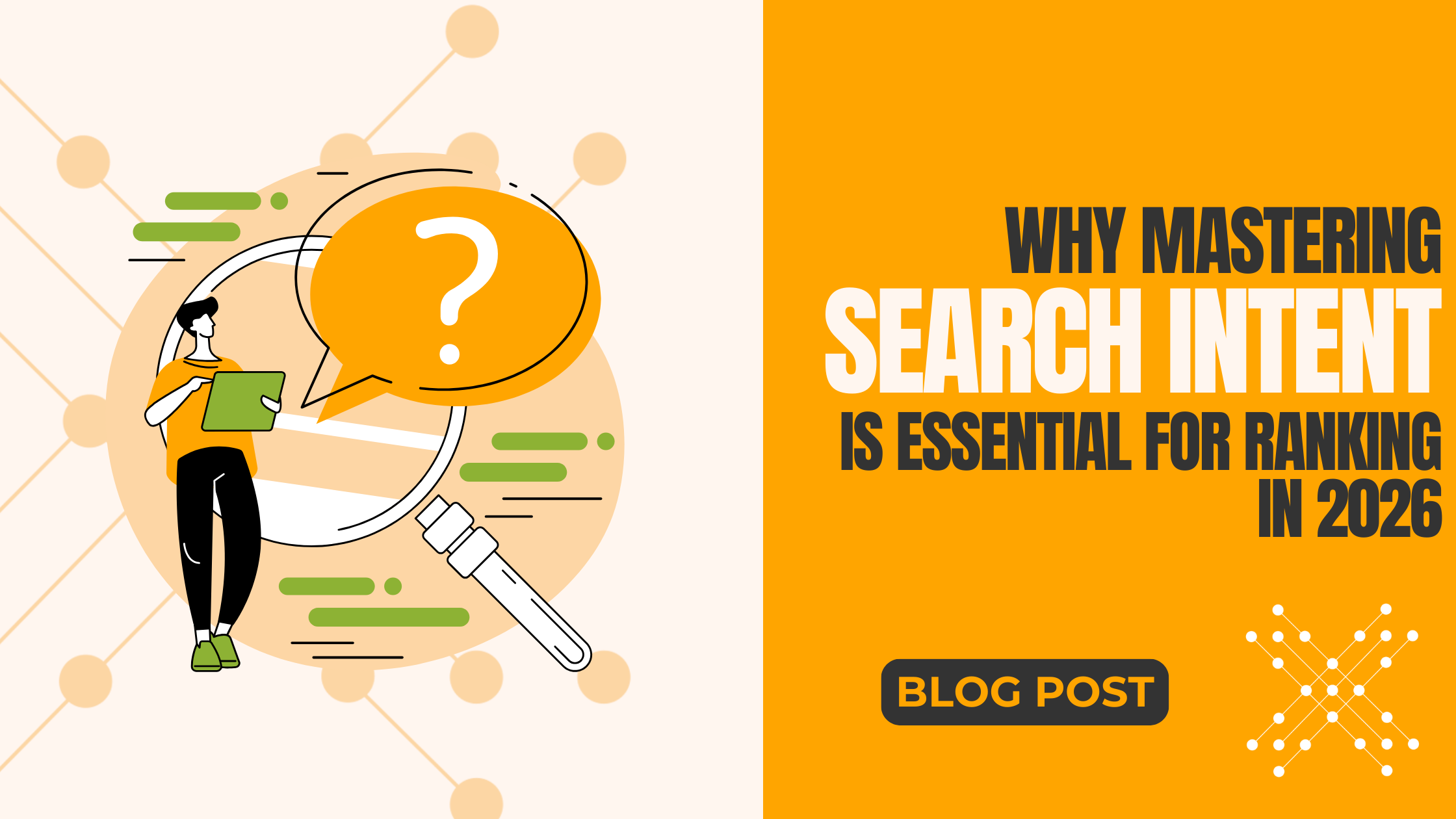
Overview
This LinkNow blog covers why understanding what your customers are really searching for is the secret to showing up in Google results and staying ahead of your competition in 2026.
Highlights
- • What Is Search Intent?
- • Why Search Intent Matters Now More Than Ever
- • How AI is Changing Search Intent
- • Practical Strategies To Optimize for Search Intent
- • Common Mistakes Businesses Make With Search Intent
- • The Future of Search Intent
- • Master Search Intent by Working With LinkNow
Introduction
Search engine optimization isn’t what it used to be. Today, climbing the rankings is no longer a matter of who can squeeze the most keywords into a page—it comes down to who can truly understand the intent behind their target audience. Every time a customer uses a search engine, they’re signaling what they want. The businesses that deliver the right type of answer, in the right format, at the right time, are the ones that win.
This blog explores why mastering search intent has become the cornerstone of SEO. From breaking down the types of intent, to understanding how AI is rewriting search, to highlighting practical strategies you can use today, we’ll show you why intent-driven optimization is the difference between ranking high and getting lost in the noise.
What Is Search Intent?

Put simply, search intent is the “why” behind a search query. It’s the reason someone types a phrase into Google in the first place. Do they want to learn something? Find a specific website? Hire a professional? Instead of focusing only on the exact words in a search, intent looks at the purpose behind those words.
Understanding this purpose matters because Google has become much better at rewarding content that genuinely satisfies a user’s need, rather than just matching a keyword. In fact, updates like Google’s Helpful Content System are designed to push pages higher in rankings if they deliver meaningful answers that align with intent.
For service-based businesses, getting this right can mean the difference between showing up in front of potential clients and being buried beneath competitors.
What Are the Different Types of Search Intent?
People use Google in very different ways depending on where they are in their decision-making journey. To create content that ranks (and converts), you need to understand the four main types of search intent:
- • Informational: When someone is seeking knowledge, answers, or guidance on a topic.
- • Navigational: When a person already knows what brand, business, or website they want to find and is searching directly for it.
- • Commercial: When someone is researching and comparing options before making a final decision.
- • Transactional: When a user is ready to make a purchase, book a service, or complete another type of conversion.
Example: Search Intent for a General Contractor
- • Someone searches “how to choose the right contractor for a home addition”: This shows informational intent. The person is looking for guidance and is probably not yet ready to hire. A blog post explaining questions to ask contractors would fit perfectly here.
- • Someone searches “best general contractor near me”: This shows transactional or commercial intent. The person is ready to compare options or make a hiring decision. A local service page with testimonials, photos of past projects, and clear calls to action would meet this need.
- • Someone searches “XYZ Construction phone number”: That’s navigational intent. They already know who they want and just need contact details.
Why Search Intent Matters Now More Than Ever
SEO has always evolved, but the shift happening these days is one of the biggest yet: Success depends less on keyword placement and more on aligning with user intent. Search engines are no longer fooled by keyword stuffing or thin content. Instead, they prioritize websites that demonstrate a deep understanding of what people truly want when they search.
From Keywords to Intent-Driven Results
Not long ago, many businesses tried to rank by cramming the same keyword into a page over and over. That tactic not only created clunky content, but it also failed to give users the answers they needed. Today, Google’s algorithms can identify the difference between keyword-heavy fluff and content that genuinely satisfies a query. In 2026, relevance and usefulness (not exact-match phrases) are the deciding factors.
The Impact of Helpful Content and Updates
Google’s Helpful Content System and ongoing algorithm improvements make intent even more important. These updates are designed to reward websites that put people first, whether they answer questions clearly, provide unique insights, or help users achieve their goals.
Search engines can now analyze context and meaning more accurately than ever before, so if your page doesn’t address the underlying need behind a search, it risks getting left behind.
Rise of Zero-Click Searches and Featured Snippets
Another major change is the increase in zero-click searches, which is when users get their answers directly on the search results page. Featured snippets, knowledge panels, and AI-generated summaries often appear above traditional links.
To compete, businesses must structure their content so it has the best chance of being pulled into these spots. That means answering questions concisely, using clear headings, and formatting information in easy-to-digest ways, like bullet points, lists, or tables.
Evolving User Expectations
Finally, user behavior continues to raise the bar. People don’t want to dig through a wall of text or click through multiple pages to find what they need. They expect fast, clear, and accurate information at their fingertips. In 2026, if your content doesn’t meet that standard, users will bounce quickly—and Google will notice.
How AI is Changing Search Intent
Artificial intelligence is rewriting the rules of search. In 2026, ranking well means understanding what people are typing and how AI interprets those queries. Search engines have become sophisticated systems that analyze context, tone, and even user behavior to deliver hyper-relevant results.
Google’s AI Overviews
Google’s AI Overviews (formerly Search Generative Experience) is a prime example of this shift. Instead of just listing links, Google now creates AI-powered summaries that pull insights from multiple sources. When someone searches, they often get an instant breakdown of the answer at the top of the page. For businesses, this means your content has to be both accurate and structured in a way that makes it easy for AI to feature.

AI-Driven Personalization
Search is also becoming more personal. AI now tailors results based on a user’s location, browsing history, preferences, and even the type of device they’re using. Two people can type the exact same query but see different results. For small businesses, this means optimizing for broad keywords, as well as for local relevance and niche-specific customer needs.
Natural Language Processing Advances
Thanks to natural language processing (NLP), Google understands nuance far better than before. A search like “best contractor for small kitchen addition” won’t just match with “contractor” and “kitchen”—AI can recognize intent, context, and comparisons. This deeper understanding allows Google to connect users with the most helpful, detailed, and trustworthy answers.
What This Means for Small Businesses
For local and service-based businesses, the message is clear: Content needs to answer questions directly. Instead of stuffing in every possible keyword, focus on creating content that:
- • Provides clear, conversational answers.
- • Anticipates follow-up questions customers might ask.
- • Uses formatting (headings, FAQs, bullet points) to make information easy to scan.
Practical Strategies To Optimize for Search Intent
Knowing the importance of search intent is one thing—putting it into practice is another. To rank well in the era of search intent, small businesses need to create content that actually answers the question behind the search.
Here’s how to make that happen:
Match Content to Query Type
Not every search deserves the same kind of content. Someone looking for information will expect a blog post, checklist, or guide. Someone ready to buy will expect a service page, pricing breakdown, or contact form.
Align your content with intent:
- • Informational: Blogs, FAQs, how-to guides
- • Commercial/Transactional: Product or service pages with calls-to-action
- • Navigational: Contact details, About pages, branded landing pages
Structure for Featured and Rich Snippets
Featured snippets (the “answer box” at the top of Google) and rich snippets (enhanced search listings with reviews, stars, or FAQs) dominate clicks.
To earn these spots, format content in ways that search engines can easily extract:
- • Use bullet points, numbered lists, and tables for quick answers.
- • Add an FAQ section with schema markup to target common questions.
- • Keep answers concise by aiming for 40 to 60 words for snippet-ready responses.
Prioritize User Experience
Google also tracks how users interact with your site. Reasonable load times, mobile-friendly layouts, and intuitive formatting are essential. If someone lands on your page and bounces within seconds, search engines will assume your content didn’t match intent. Keep pages clean, clear, and easy to scan.
Diversify Content Formats
Search intent isn’t satisfied by text alone. Some users want to read, others want visuals, and many prefer video. Offering a mix of formats helps capture different preferences and boosts engagement:
- • Blog posts and articles for depth
- • Videos and demos for “how-to” searches
- • Comparison charts and guides for decision-making queries
Keep Content Fresh
Search intent evolves as industries change, new products launch, and customer behavior shifts. Regularly review and update your content to ensure it stays relevant. A blog post written two years ago may no longer reflect what today’s users expect. Fresh updates help satisfy intent while also sending positive signals to Google.
Common Mistakes Businesses Make With Search Intent
Even when businesses understand the importance of search intent, it’s easy to trip up. Many well-meaning SEO strategies fail because they focus on ranking signals instead of real user needs. Avoiding these common pitfalls will help keep your content aligned with what customers actually want.
1. Over-Optimizing for Keywords
One of the biggest mistakes is still treating SEO like it’s 2010 by stuffing pages with keywords instead of focusing on the question behind the search. While you may hit every variation of a phrase, the content often feels clunky and unhelpful. Google’s algorithms now prioritize clarity and usefulness, so a keyword-heavy page that doesn’t answer the query won’t rank well.
2. Mislabeling Content Type
Another common issue is serving the wrong kind of page for the query. For example, a business might try to rank a hard-selling service page for a search that clearly has informational intent. Instead of helping, this confuses users and increases bounce rates. The better approach is to provide an educational blog post or guide when people are still in the research stage and save the sales pitch for transactional searches.
3. Neglecting Mobile and Voice Search
Search intent often looks different on mobile devices and voice assistants. Mobile users expect scroll-friendly content that displays correctly, while voice queries tend to be longer and more conversational (e.g., “Who’s the best plumber near me open now?”). Ignoring these differences can cause your business to miss out on valuable opportunities where intent is crystal clear.
4. Forgetting Local Search Intent
For small and service-based businesses, local search intent is crucial. Many customers aren’t just looking for a service—they’re looking for the best one that’s close to them. If your content doesn’t include location signals (like city names, service areas, and maps), you’ll lose ground to competitors who do. Optimizing for “near me” searches and building out local pages ensures you meet this intent head-on.
The Future of Search Intent
Search intent will continue to evolve as technology and user behavior change. While 2026 marks a turning point, the years ahead promise even greater shifts in how people search and how businesses must respond.

More Conversational Queries and AI Summaries
As voice search, smart assistants, and AI-powered platforms become more widespread, queries will grow increasingly conversational. Instead of typing short phrases like “best accountant Boston”, users will ask full questions such as “Who is the most trusted small business accountant in Boston, and what do they charge?” Search engines will respond with AI-generated summaries that pull information from multiple trusted sources, giving users an immediate overview instead of a long list of links.
Authority, Trust, and EEAT Take Center Stage
In this environment, EEAT (experience, expertise, authoritativeness, and trustworthiness) will only become more important. Google and other search engines want to feature content that answers questions and comes from credible sources. Businesses that can showcase genuine expertise, provide evidence of experience, and build online trust will stand out in AI-driven results. This means more emphasis on customer reviews, case studies, author bios, and citations from authoritative sources.
Intent Mastery Will Become the Great Divider
In the years ahead, mastering intent will be the difference between businesses that thrive and those that vanish from search visibility. Companies that consistently align their content with user needs will earn rankings, snippets, and AI mentions. Those who fail to adapt and cling to outdated keyword strategies or ignore customer behavior will find themselves invisible.
Master Search Intent by Working With LinkNow
If you think search intent is just another SEO buzzword, think again. In 2026, Google and other search engines will be laser-focused on delivering results that match what people really want, not just what they type.
The winners will be the businesses that combine clarity, authority, and trust with content designed to match intent at every stage of the customer journey. By updating your strategy today, you’ll build credibility and create a smoother path for customers to choose you over competitors.
If you’re ready to future-proof your digital presence, start by auditing your current content with LinkNow. Our team will help you identify any gaps in your online presence and rework your strategy for today’s consumers.

